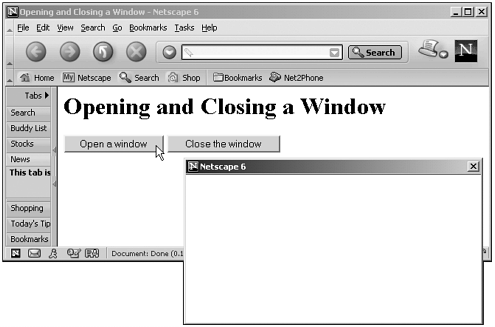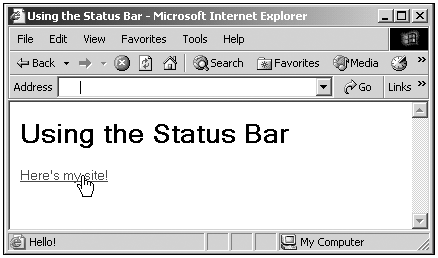The window Object
The window ObjectThe window object is the big cheese object in the browser object model, and it contains other objects, such as the document object, the location object, and others. The window object refers to the current browser window, and it's got plenty of useful built-in methods , such as alert , which displays a new alert dialog box, and open , which opens a new browser window. We've already seen the alert method in action, so here's an example putting the open method to workwhen the user clicks a button here, a new browser window will open; when the user clicks the other button, the new window will close: (Listing 04-02.html on the web site) <HTML> <HEAD> <TITLE>Opening and Closing a Window</TITLE> <SCRIPT LANGUAGE="JavaScript"> <!-- var window1 function openWindow() { window1 = window.open("", "", "HEIGHT=200,WIDTH=400") } function closeWindow() { window1.close() } // --> </SCRIPT> </HEAD> <BODY> <H1>Opening and Closing a Window</H1> <FORM> <INPUT TYPE="BUTTON" VALUE="Open a window" ONCLICK="openWindow()"> <INPUT TYPE="BUTTON" VALUE="Close the window" ONCLICK="closeWindow()"> </FORM> </BODY> </HTML> You can see the results of this code in Figure 4.4, where I've opened a new window. We'll see more on the open method in Chapter 8, "Using window and frame Methods and Events." Figure 4.4. Opening a new browser window. The window.status object also gives you access to the browser's status bar (which appears at the bottom of the browser), something that's very popular with JavaScript programmers. Here's an examplein this case, I'm displaying Hello! when the mouse rolls over a hyperlink, and Good Bye! when it leaves the hyperlink (the JavaScript functions called here must return a value of true, as we'll see when we cover the window object in Chapter 7, "Using window and frame Properties," and in Chapter 8, or the browser will just display the URL of the hyperlinkits default behavior, in this case): (Listing 04-03.html on the web site) <HTML> <HEAD> <TITLE>Using the Status Bar</TITLE> <SCRIPT LANGUAGE="JavaScript"> <!-- function sayHello() { window.status = "Hello!" return true } function sayGoodBye() { window.status = "Good Bye!" return true } // --> </SCRIPT> </HEAD> <BODY> <H1>Using the Status Bar</H1> <A HREF="http://www.starpowder.com" onMouseOver="return sayHello()" onMouseOut="return sayGoodBye()">Here's my site!</A><P> </BODY> </HTML> You can see the results of this code in Figure 4.5. Figure 4.5. Using a browser's status bar. You'll find the properties, methods, and events of the window object in Table 4.6. Not all properties, methods, and events will be supported in all browsers, of course. We'll get the full story on browser version for each property, method, and event of the window object in Chapters 7 and 8. Table 4.6. The Properties, Methods, and Events of the window Object
|

